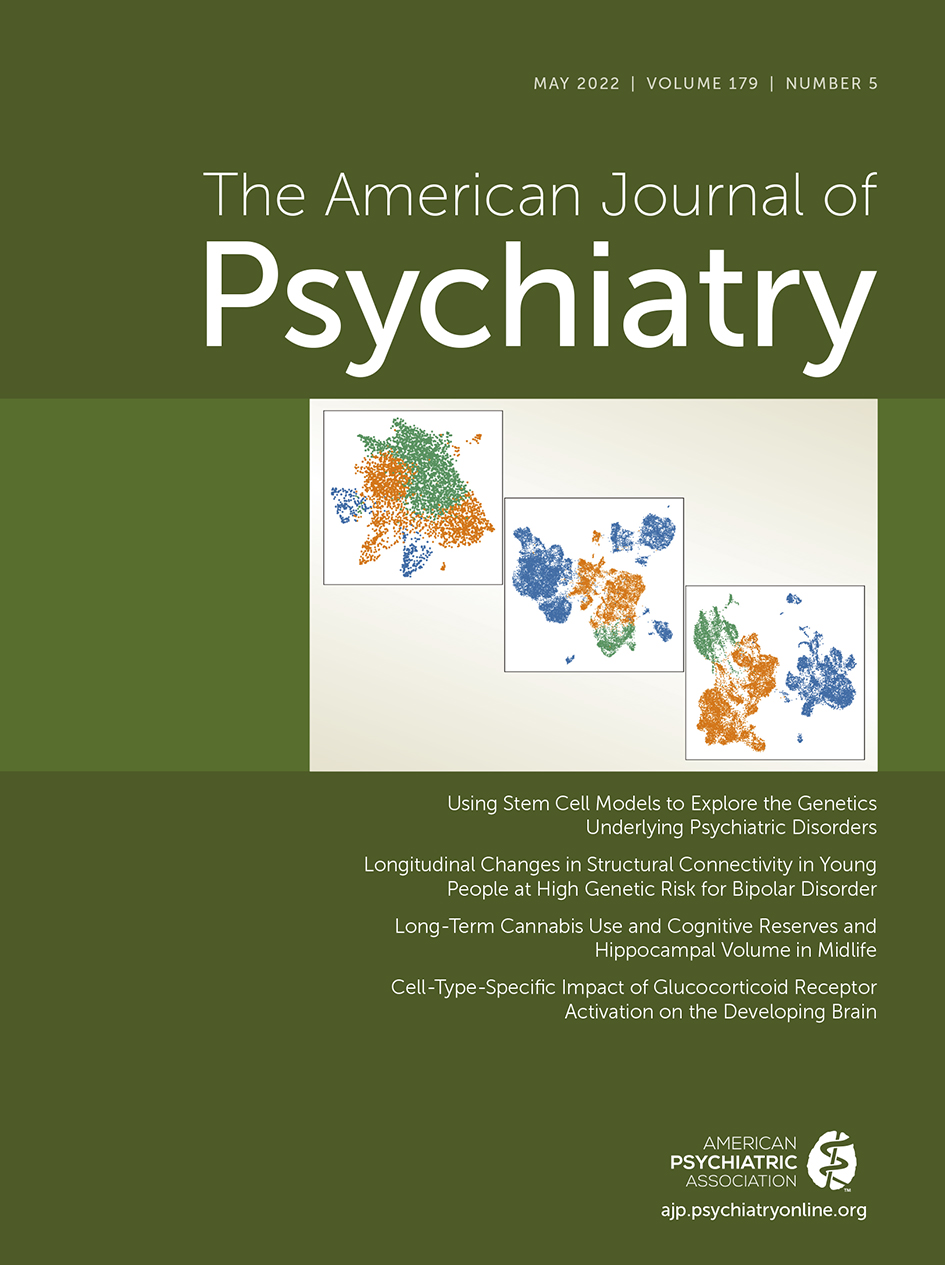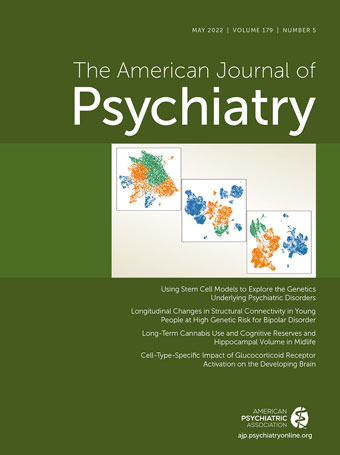Maladaptive maturation of the nervous system underlies mental illness (
1). Genes and external factors interact from conception on to instruct this maturation process toward potentially more or less illness risk. Understanding how these factors influence nervous system development in the diverse human population will improve diagnostics and interventions (
2). Cutting-edge basic model systems are rapidly developing to dissect this poorly understood interaction in humans.
Why are basic research models important in psychiatry? The answer is the same as in virtually all fields of medicine: model systems afford unique opportunities for experimentation that are critical to understanding mechanisms of illness and investigating potential therapeutic interventions. Psychiatry has a deep history of building animal models to test biological hypotheses (e.g., dopamine augmentation as a psychosis model, serotonin depletion as a depression model) and to understand how behavioral alterations read out in brain biology (e.g., learned helplessness as a model to study the biology of depression). Genetically engineered mice have become a workhorse approach to test how variations in genes implicated in psychiatric illness affect brain function and behavior and as a tool for testing interventions to remediate engineered ill effects. While these efforts have built a substantial foundation of basic information about brain-behavior relationships, it is a familiar refrain that all models are flawed, some more than others. Rodent models are inescapably handicapped by the evolutionary distance between mice and humans and the limitations of the mouse genome in representing the human genome. Nonhuman primate models bring us closer to humans, but even these fail to fully capture the complex genetics and human-specific features that underlie most psychiatric diseases.
The opportunity to build models based on human cells has become a mainstay of basic research of pathogenic mechanisms and drug development. For example, human embryonic kidney 293 cells (HEK 293 cells), an immortalized line of cells originally isolated from fetal tissue in 1973, are widely used in academic research and industry to study basic cell biology and the effects of pathogens, and as cellular factories to manufacture proteins. In contrast to HEK 293 cells, which have limited capacity to represent neuronal function, SH-SY5Y cells, originally isolated from a bone marrow biopsy of a female child with neuroblastoma, have been extensively studied as a model of neurons in health and disease. While these cell models have played a critical role in understanding basic neuronal function and dysfunction, they too are limited by their stereotyped biology. They are based on cells from only one human being and as such cannot address how variations in human genomes contribute to variable risk and resilience and response to treatment.
Until relatively recently, the capacity to study genetically variable human cells has been limited mainly to immortalized B lymphocytes, mostly as models of the peripheral immune response. Lymphocytes are an easily isolated cell population that can be studied in large samples from multiple human genomes. Interestingly, B lymphoblasts express many neuronal genes and manifest some properties that have been explored as models of how genetic variation influences early neuronal function (e.g., migration and interactions with neuronal chemoattractants) (
3). Nevertheless, they are not neurons and have restricted applications as models of brain-relevant biology.
The sea change in studying human illness at the basic cellular level followed the discovery in 2006 by Shinya Yamanaka, at Kyoto University, that a cocktail of four transcription factor proteins could reprogram mature skin cells into pluripotent stem cells (induced pluripotent stem cells, iPSCs) (
4), for which he shared the Nobel Prize in 2012. This remarkable discovery essentially turns adult human cells into some of the earliest cells in a human embryo. These pluripotent cells can then be coaxed to differentiate into neurons, astrocytes, and microglia and to recapitulate genetically encoded features of human brain that are remarkably similar to fetal brain development, including production of functional synapses and circuits. Because skin or even white blood cells of any individual can be transformed in this manner, the starter cells for experimentation can be selected based on a particular diagnosis or a particular genome. For psychiatric disorders, cellular phenotypes have been observed that are consistent with patient endophenotypes while also revealing novel biology, including neurons from schizophrenia patients that display neuronal hippocampal connectivity deficits (
5) and models of autism patients with fetal macrocephaly displaying GABAergic cell overproduction (
6).
There are even hints that these models may reveal aspects relevant to clinical care. In one recent study (
7), neuronal activity measures in stem cell–derived schizophrenia patient neurons predicted psychotic symptoms and, with almost absolute accuracy, an aspect of cognitive deficits in the adult individuals from whom the cells were made. These fascinating results raise the startling possibility that fundamental properties of cell-cell communication underlying higher-order human behavior may be represented in these early cell systems. The neurons in a dish also have recapitulated patient response to specific drugs, such that activity phenotypes in neurons derived from patients with bipolar disorder are rescued by lithium only in lithium-responsive patients and not in nonresponders (
8).
However, with all the promise, these are still early days in stem cell models for psychiatric research. There is considerable uncertainty about the best approaches to take to model particular aspects of these early states, and cells grown as a single layer in media have different properties from cells grown in three-dimensional “blobs,” called organoids or spheroids. Two-dimensional systems are less complex and more practical for single-cell physiological experiments, but three-dimensional systems are sustainable for much longer periods and establish more diverse cell types and connectivities (
9). In 2008, Eiraku and colleagues (
10) used embryonic stem cells to develop the first three-dimensional brain models and demonstrated that the cells self-organize into complex structures reminiscent of those seen in vivo, follow neurogenesis programs that are similar to those of the developing cortex, and give rise to functionally active neurons. In 2013, Lancaster and colleagues (
11) created the first human stem cell–derived cerebral organoids by modifying Eiraku and colleagues’ approach and providing an extracellular matrix scaffold surrounding the three-dimensional cell aggregates. These first cerebral organoids recapitulated diverse developmental processes, including abnormal neurodevelopment in a microcephaly model. A modified version of this cerebral organoid model is the starting method used by Cruceanu et al. in a study reported in this issue of the
Journal (
12).
Using varying models and approaches, other investigators have coaxed cells with different levels of extrinsic signaling factors to generate more specific cell types and brain regions, including midbrain with functional dopaminergic neurons (
13), cerebral cortex with laminar structure (
14), and hypothalamus (
15). Many of these three-dimensional cultures are smaller than the Lancaster method, do not use extracellular matrix scaffolds, and are termed “spheroids.” To model long-range functional connectivity between brain regions, spheroids patterned to different brain regions can be fused together into “assembloids” (
16). For example, Andersen et al. (
17) fused cortical and hindbrain/spinal cord spheroids together and showed that stimulating the cortical neurons triggers robust contraction of skeletal muscle cells. These three-dimensional models are breathtaking, but they have important limitations. Among them is that organoids lack vasculature, and they are therefore hypoxic and unhealthy at their more inner parts. Creative approaches to deal with this problem include implanting organoids into mouse brain to borrow vasculature and improve the health of the living cells (
18).
Developmental risk for various psychiatric disorders is influenced by environmental factors that complicate pregnancies. Glucocorticoids are one well-established effector molecule that mediates environmental exposures during pregnancy complicated by a variety of stresses, including nutritional deficiencies, infection, medical illnesses, and psychological stress. Glucocorticoids also are essential for normal fetal organ development. Therapeutic administration of synthetic glucocorticoids prenatally promotes organ maturation and prevents preterm birth but may also cause adverse mental health outcomes.
Cruceanu et al. used a rigorous protocol for glucocorticoid exposure to model its effects on early brain development in iPSC-derived cerebral organoids, map the acute and sustained transcriptional response at a single-cell level, and identify a uniquely neuronal response involving genes that are well established to influence behavioral phenotypes and disorders in humans. One of the challenges faced by Cruceanu et al. in exploring the effect of an environmental exposure on an organoid system is that cerebral organoids made from different individuals tend to vary in the composition of specific neuron subtypes. This variability, combined with the difficulty of relating higher-order disease phenotypes to reproducible mechanisms and endophenotypes in a dish, is a major challenge in applying organoid models to psychiatric research. Notably, Cruceanu et al. advanced through these challenges and found that even with individual donor line variation, the glucocorticoid response converges on neurodevelopmental and psychiatric disorder pathways. Genetic and epigenetic factors drive organoid variability, which has been a long-standing issue for all stem cell models. Molecular characterization of individual cells in these models, including RNA sequencing and epigenetic analyses, allows quantification of this variability and controls for heterogeneity by restricting comparisons to similar cell types.
When Cruceanu et al. compare the genes differentially expressed upon glucocorticoid stimulation specifically in neurons, the effects are not identical between the donors, and only ∼30% of differentially expressed genes in one donor are differentially expressed in another donor. Notably, however, the way the transcriptional programs change is shared between the donors. The genes that respond to glucocorticoid exposure in neurons are enriched for genes in loci associated with neurodevelopmental, behavioral, and psychiatric disease. This is true for all three donors, and is most pronounced in neurons, driven by transcription factors essential for neural cell specification, and the direction of differential expression is significantly shared. The data from Cruceanu and colleagues’ experiments provide unique insights into the potential molecular effects of glucocorticoids in early brain development and the implications for genetic risk for psychiatric illness.
The development of cell systems based on human genomes and the early patterning of brain development is a sea change in experimental biology and modeling of human illness. In psychiatry, the potential for uncovering the mechanisms of altered trajectories from very early in life has never seemed so promising, and the possibility of using these models to find new therapies or preventive interventions is dramatic. The Cruceanu et al. study is important work addressing several critical challenges, and it lays the groundwork for using human stem cell organoid models to develop a deep understanding of gene and environment interactions in early human brain development. Discoveries from these rarefied human cell models will drive the creation of a new generation of animal models, which are needed to better define how perturbations in early development translate into altered trajectories at the level of the in vivo brain.

